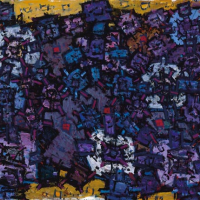43. ROGER KEMP

Art serves countless purposes in our lives, from simple decoration, commercial enterprise, political protest and cultural identity, to explorations of the human condition and our relationship to spiritual dimensions, belief and our relationship with the world and the cosmos. As an artist, Roger Kemp was very firmly in that last tradition, spending a lifetime searching for a visual interpretation of the unseeable and unknowable.
Born in 1908 into a close-knit, isolated mining community near Bendigo, Kemp was steeped in fundamental Methodism and a healthy dose of Welsh superstition. His early life was straitened, but not joyless, as singing and music was integral to the Welsh religious observance and remained a cornerstone of his whole life. A mining disaster saw the family move to Melbourne on the eve of World War One, only to have further tragedy strike when, not long after, his father was killed in a road accident. Brought up by his mother and sisters, Kemp set out on his own chosen path as an artist and singer, despite the daunting rigours of the Great Depression, which arrived just as he reached maturity. He had left school at fourteen, but made the effort to attend night classes at the National Gallery School and the Working Mens College.
With the help of his sister he was able to attend the National Gallery of Victoria School as a day painting student from 193335. The school curriculum was narrow, rigid and constrained by the arch-conservative views of its leaders and teachers, L. Bernard Hall (1859-1935), W.B. McInnes (1889-1939) and J.S. MacDonald (1872-1952). Kemp worked hard, complying as best he could with the demands of the teaching and the proscription that tonal realism was the only acceptable style. He was not new to a disciplined and constrained approach to life, and his inward nature and deep thinking carried him through until his third year, when he began to explore his own path towards an expressive form of cubism. It did not impress his mentors, but Kemp, now using the name of Roger rather than his given names of Francis Roderick, was not perturbed by the hostility and lack of recognition. On leaving the school he simply set about creating his own style, happy to experiment with an increasingly modern vision, choosing not to exhibit or attempt to sell his work. Only after his marriage to art teacher Merle McCrohan in 1943 was he persuaded to exhibit, with an exhibition that saw minimal sales but, encouragingly, positive reviews.
Over the next decade, Kemp gradually built a reputation as a thoughtful and deeply serious artist, using a form of abstraction that sat well with the new forms that had blossomed after World War Two. His complex arrangements of stark figures gradually gave way to an ever-simpler series of motifs, which he constantly rearranged and refined. Each new iteration was an attempt to reach a synthesis, some still point where the viewer might be connected directly to the larger forces of the cosmos. These were not inherently religious symbols, although some saw the crosses and circles as Christian in nature. Rather, Kemp was trying to distil every possible form to its basics, as though taking Bauhaus teaching and bringing it to a new, more personal and expressive form.
Success in most of the major prizes of the 1960s had reassured the artist he was at last reaching an audience and he doggedly kept to his severe, ascetic and very personal path. His works, both in painting and printmaking, grew in size, but always retained the intensity of the gestural mark, being in the manner of painted drawings where line, however thick and crusty, was the essential element of the composition. At times the elemental forms were huge and few in number, like giant stained glass windows in a deep and narrow palette, or at other times, like the present work, where despite the extent of the canvas, the symbols have been kept small in scale and large in number. In this painting, unusually, he has created a distinct and contrasting coloured border that floats the matrix away from the edges, allowing it to hover over the surface. While some of his abstractionist contemporaries, such as Fred Cress (1838-2009), eventually left abstraction and returned to the realism of their formative years, once on his path, Kemp never deviated from his deep and philosophical meditations on art, man and the infinite. He was a rock and, for many younger artists, a guide as to what art in its purist form might achieve.
Gavin Fry BA[Hons] MA MPhil